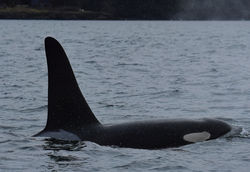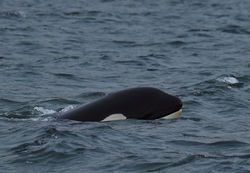Encounter #8 - Jan 27, 2024
 J16 tailslapCopyright © 2024 Center for Whale Research |  J38Copyright © 2024 Center for Whale Research |  Copyright © 2024 Center for Whale Research |
|---|---|---|
 Copyright © 2024 Center for Whale Research |  J59 and J37Copyright © 2024 Center for Whale Research |  J26Copyright © 2024 Center for Whale Research |
 the J11sCopyright © 2024 Center for Whale Research |  J26Copyright © 2024 Center for Whale Research |  Copyright © 2024 Center for Whale Research |

Your financial support makes our work possible
Please DONATE
EncDate:27/01/24
EncSeq:1
Enc#:8
ObservBegin:02:11 PM
ObservEnd:04:08 PM
Vessel:New Vessel
Staff:Dave Ellifrit, Michael Weiss, Katie Jones
Pods:J
LocationDescr:San Juan Channel
Start Latitude:48 34.86
Start Longitude:123 02.40
End Latitude:48 37.59
End Longitude:123 04.97
EncSummary:
Michael received reports of a large, spread out group of killer whales making their way down San Juan Channel a bit after noon. Colleagues from OBI and Orca Network soon reported from shore that it was J pod. Michael, Katie, and Dave left Snug at 13:48 and headed north through Mosquito Pass and Spieden Channel, receiving reports along the way that the whales had turned around and were now northbound in San Juan Channel.
The team arrived on scene at 14:11 just north of Pt Caution. Most of J pod was in a single resting group, while a few adult males and juveniles socialized on the periphery. The J16s (except for J36) were initially the furthest whales inshore, followed by the J11s, J19s, J36, and J53, with the J35s being closest to the vessel. J45 and J44 socialized behind the rest of the group.
J26 broke off shore to play with J44 and J45, and J16 and J42 fell behind the rest of the group. The team got a good look at these two, and confirmed that there was no calf travelling with them. The team then briefly paralleled the group of three males as J16 and J42 passed them up.
Before going back to the main group, the team tried to catch up to J16 and J42. J39 broke off shore in front of them, while the two females went on a long dive. When they came back up, they were inshore of the team, closer to the main group of whales. After one more pass on the two females, the team moved back towards the main group.
Back with the main group of whales, the team was able to get good looks at both J40 and J46, two more potential mothers for J60. Neither female had a calf travelling with them. The team also documented J37 and J59 travelling with the J22s.
By this point the team had photographed every pod member other than J60, and it was becoming clear that the calf was no longer there. As the whales neared Spieden Channel, the team launched the drone to observe the group's behavior and to try to determine if any females were very visibly pregnant.
The whales split into several groups as they entered Spieden. The first group the team flew over was the J35s, followed by the J19s (less J51) just a few body lengths ahead. They then switched groups, moving in shore to fly over the J22s, J37, and J59, who rolled around socializing beneath the surface. Ahead of this group were the J11s (less J39), J46, and J40, also engaged in relaxed socializing as they moved west through the channel. Behind and offshore of this group, J53 and J36 continued to socialize with each other, soon joined by the J22s, J37, and J59. J49 soon also joined this group. The team moved over to a group of males (J26, J44, J45, J51), who were socializing off shore.
The wind began to pick up and it was threatening to rain, so the team landed the drone. The team stayed with the whales as they made their way west until the reached the west entrance of Roche Harbor, where the team ended the encounter at 16:08.
Based on this encounter, we now believe that J60 is, sadly, deceased. Unlike adult whales, which may travel a significant distance from other whales for extended periods, we would not expect a one month old to be on its own for the length of time we observed the group.
Photos taken under Federal Permits
NMFS PERMIT: 27038/ DFO SARA 388


